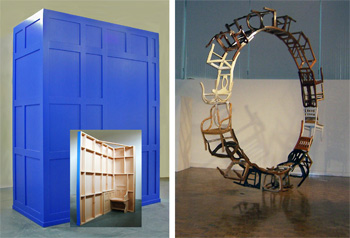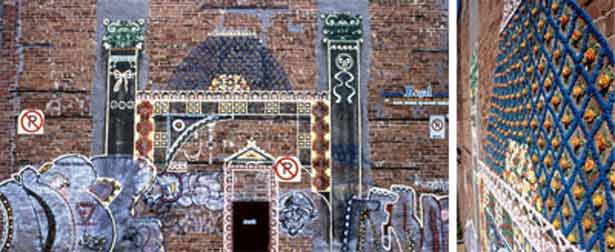Informed by Function
Feb. 6 – May 15, 2008
Reception: Tue. March 11, 6 to 7:30 pm
Bedford Park Boulevard West, Bronx, N.Y. 10468
Tel 718-960-8731
fax 718-960-6991
Alexandre Arrechea, David Baumflek, Jean Blackburn, Carlos Bunga, Francis Cape, Pedro Cruz-Castro, Marcia Grostein, Hisae Ikenaga, Michelle Jaffé, Friedrich Kunath, Forrest Myers, Iván Navarro, Marc André Robinson, Courtney Smith, William Stone and Madeline Weinrib
Throughout the early 20th century from Bauhaus design to Duchamp’s ready-mades, there has been a dialogue between art and the domestic object. Informed by Function explores this dialogue in sculptural objects influenced by the vocabulary of furniture, design, and architecture. Familiar yet displaced or transformed, these forms draw on sources ranging from industrial design to the natural world. Functionality is an issue in each and the basics of ergonomics make much of the work body-conscious. “Found objects,” with their history and patina of use are repurposed and reconfigured. The hand-built and mass-produced are incorporated in work throughout the exhibition. Subversion of intent, political allusion, and narrative content are among the issues raised by these hybrid works–along with wit and humor.
The exhibition includes Alexandre Arrechea’s Secret Meeting (2006), a lounge chair made of transparent Plexiglas from which a battleship emerges. Secrecy, transparency and conspiracy are elements in his work. Iván Navarro’s Black Electric Chair (2006) obliquely references torture and capital punishment with metaphor and double entendre. Francis Cape’s Alma (2003) mixes an understated minimalism with the quiet intimacy of domestic architecture. The work presents a finely crafted wainscoted wall on one side and on the other exposed studs with a seat nestled within.
William Stone’s Corrected Chairs (2008) and Mixed Metaphors (2000) are funny and witty. In the former Stone undermines the notion of stability associated with chairs. Jean Blackburn’s Serviette (2002) humorously named for the napkin folded over an exposed plywood armature, is a deconstructed armchair that has been reassembled.
Constructed from discarded chairs, Marc Andre Robinson’s 15’ high installation was developed as a site-specific work and was created using traditional joinery techniques. Colorful abstract forms created from cardboard appear to evolve from small tables in Carlos Bunga’s constructions and give a suggestion of the large-scale interventions he creates emphasizing transience and transformation. Courtney Smith’s sculptures are reassembled, cut-up pieces of old furniture juxtaposed with geometric shapes of Formica and plywood. She creates structures with no fixed configuration. David Baumflek’s Still Life (2007) plays with ideas of display and consumption and with the longing for unfulfilled desire. Made from white wooden tables piled on top of each other, a platter of unattainable fruit is visible in a mirror hung from the ceiling.
Marcia Grostein’s chairs are like anthropomorphic beings moving in space. Elegant and poised, they seem like organic shapes engaged in a choreography. The body and its relationship to clothing are also implied in Michelle Jaffe’s Maillot Maillol (2004). Her sculpture is playful and whimsical collapsing the shape of a chaise lounge with the one of a female bathing suit. Known for work that hovers between sculpture and furniture, Forrest Myers’ wire piece Parker (2006), looks like the animated line of a “gesture drawing.” Nature and the man-made are wedded in Pedro Cruz-Castro’s Hybrid III, (2006) composed of a cabinet with deer feet.
Madeline Weinrib’s Persian Illusion (2008) is a carpet made of a mirror and guoache. Inspired by the style of traditional Persian carpets, it comes to life in reflections on the wall. Hisae Ikenaga’s 12’ bas-relief depicts furnishings using two-dimensional strategies of illusion. Its soft forms hover 2” from the wall, creating shadows as they spill onto the floor. Illusion plays a significant role in Friedrich Kunath’s Where in the world are you now (2007) in which half an upright piano is made whole by an image reflected in a mirror. The piano keys strike notes of Glenn Gould’s performance of Bach’s “Goldberg Variations.”
Informed by Function is co-curated by Claudia Calirman and Susan Hoeltzel. An online catalogue is available at www.lehman.edu/gallery . This exhibition has been made possible with support from the NYC Department of Cultural Affairs and the New York State Council on the Arts




